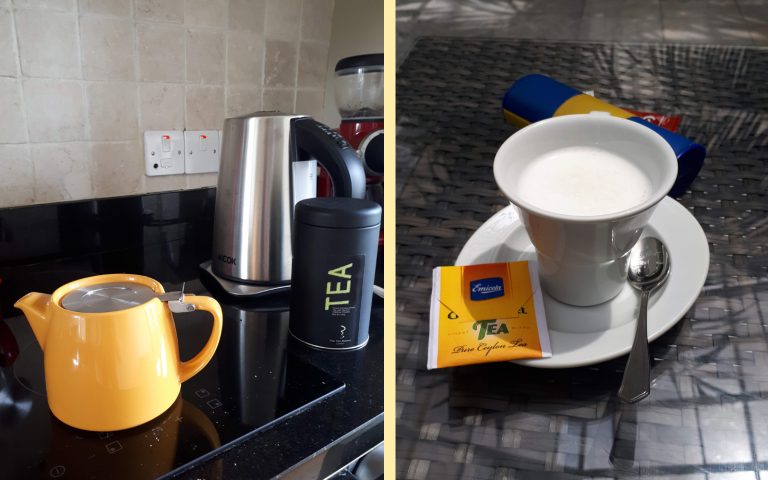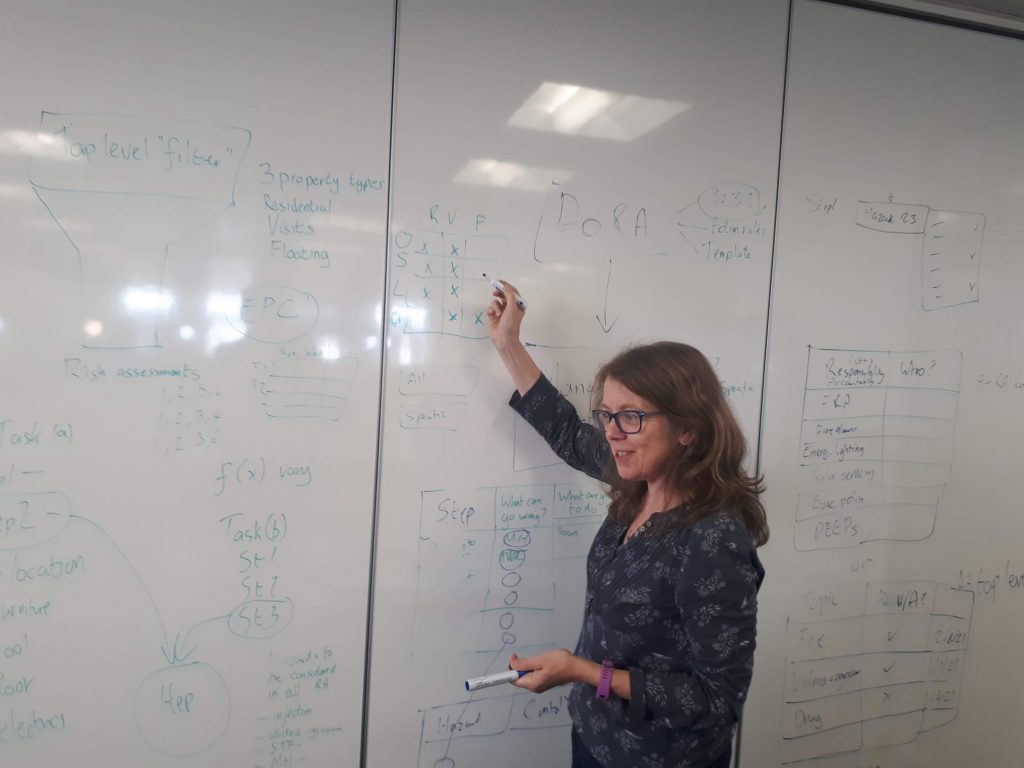Chapter 2: Understand what you are assessing
2.1 What is this risk assessment for?
You need a clear description of what you are risk assessing. I was asked to support a team of facilities staff with risk assessment, and I started by looking at their risk assessment for “changing a fuse.” My first question was simple: what sort of fuse are you changing? “I guess it’s the 3‑amp fuse in a plug,” said one person. “No, I think it means changing the circuit breaker in the distribution board” suggested another. A third person look confused “I don’t think it would be either of those. I think it’s the fuses in the transformers”. The risk assessment was vague enough to apply to any of these, and general enough to be of use to none.
The description should be clear about whether you are risk assessing a location, or a task, or both. One risk assessment for a laboratory described in detail how flammable chemicals were stored in a fire safe cupboard. What happened when the flammable substances were being used was not documented.
This chapter describes how to use Task analysis to get a better understanding of the task, and how to apply a structured What if technique to that analysis.

2.2 Task analysis
If the risk assessment is for a task, the best description is provided by a task analysis. For a single process, the task analysis can be a simple one-layered description of the steps needed. For a more complex project or operation, a hierarchical task analysis might be needed. The risk assessment can then consider each task step.
Ask yourself: How many hazards can you think of for the task of making a cup of tea?
When you have a number, take a look at the simple task analysis for making a cup of tea, and consider a hazard for each task step. Don’t think about likelihood – just write down the worst thing that could go wrong at each point.
Ask yourself: Did you think of more hazards as a result of the task breakdown than you did from the simple description “make a cup of tea”?
You might argue that you found more hazards with the task analysis because you don’t make tea the way I do. And that reinforces the point – if you base your hazard identification on your idea of what people do when they change a fuse or make a cup of tea rather than what they actually do, it is likely you will miss something out.

Task steps for making a cup of tea:
- Unplug the kettle
- Carry the kettle to the sink
- Empty any existing water into the sink
- Fill the kettle with cold water
- Plug in the kettle and switch on
- When the water has boiled, pour some into the teapot to warm it
- Take the teapot to the sink and empty the warming water
- Place leaves in the pot
- Pour boiling water onto the leaves in the pot
- Wait three minutes. If milk is required, pour into empty cup
- After three minutes, pour the tea into the cup
Although producing a task analysis sounds like an extra, time-consuming step in the process of risk assessment, it is an excellent way of getting people talking about the task you are risk assessing. You need to work with those doing the task, managing the task, and where possible those impacted by the task. The task analysis for changing a fuse (once we agreed which type of fuse change we were going to assess) revealed other misunderstandings about who could carry out the task and the controls needed. In another setting, a task analysis of typical work at height carried out by an office-based facilities team identified quickly that there was no safe way to carry out work over a desk. Moving the desks to use a ladder would involve heavy manual handling and disruption to electrical cables. A technician admitted to waiting for people to go home so he could climb on their desks. We purchased specialist equipment for working over desks safely, cutting down the need for overtime payments as well as reducing the risk of a technician falling when working alone. The time to produce the task analysis made the rest of the risk assessment process run smoothly, and helped to determine when reviews were needed.
You might already have documents that could act as a task analysis. Instructions, procedures and method statements might all contain task steps. However, these are not always an accurate reflection of how work is really done. Existing documents can be useful for prompting questions about how work is done, but I’ve found a blank whiteboard prompts more realistic answers.

2.3 Describing a location and equipment
Describing a location and listing equipment is usually easier than describing a task, but needs to be done systematically so that everyone is clear on the location being risk assessed. Try to include a plan or map of the room, the building or the site covered, as well as photographs. If that’s not possible, include a list of room numbers, or state the floor or building covered.
Asbestos surveys specifically explain which locations have not been risk assessed. For example, the space above the ceiling, under a floor or within a door or wall. And yet, it is rare to see such exclusions explained in other risk assessments.
An asbestos survey will include photographs of each location assessed, along with the conclusion. A good fire risk assessment will include photographs of each hazard identified. The technology is there now for people to take, upload and insert images to documents in seconds, and yet how many ordinary risk assessments include photos?
These approaches also suggest a solution to another dilemma raised by the apparently simple task of “identifying the hazards.”
Ask yourself:
We can learn from the way hazardous substances are managed. Laboratories and similar users of multiple substances maintain an inventory. They give an initial risk rating to each one substance, and record on the inventory the decision as to whether the substances (and the use to which it is put) requires a more detailed risk assessment. So why not do the same for a location? See the example in the table below.
Location equipment inventory
| Object/ equipment/ tool | Further assessment needed? | Included in: |
|---|---|---|
| Vice | Yes | Woodworking risk assessment |
| Chisels | Yes | Woodworking risk assessment |
| Electric drill | Yes | Electrical inspection Woodworking risk assessment |
| Work bench | No | not applicable |
| Fixed sanding machine | Yes | Woodworking risk assessment LEV inspection and maintenance |
| Pillar drill | Yes | Electrical inspection PUWER checks Metalworking risk assessment |
You can add additional columns, for example to show that you have carried out the assessment, to set a deadline for assessment or review, or to assign someone as responsible for the assessment. Tools might also have plant numbers, and the “included in” column can include more specific references and dates of assessments.
Note that the examples given are not all to a document labelled as a “risk assessment.” If all electrical tools undergo a regime of periodic and before use inspections, this is an assessment of the risk; if all powered tools have been checked against a PUWER checklist, this forms part of a risk assessment. Some items will be included in more than one type of assessment. We return to the issue of documenting risk assessments in Chapter 13.
2.4 Systematic examination
Once you have a clear statement of the scope of your assessment (whether by task analysis, location description or inventory) you can examine each element, systematically, to identify hazards. There are several techniques which can be borrowed and modified from industries used to dealing with major hazards.
A simple approach is to ask “what if?” questions at each stage. Perhaps you did that naturally when looking at the “making tea” task analysis. For example, for the task “Carry the kettle to the sink” you might ask “What if the person carrying the kettle drops the kettle?”
For some tasks it might be sufficient to see what questions come up around “what if?”. However, a more systematic approach is to consider a set of guidewords.
HAZOP (Hazard & Operability analysis) is a highly structured and rigorous approach to identifying deviations from normal or expected operations in chemical engineering. Characteristics such as temperature, flow and pressure are combined with deviations such as MORE, LESS and REVERSE to create questions about every component. This forces the HAZOP team to consider possibilities that otherwise might not be considered, and concerns that otherwise might not have been voiced. For example, what if the concentration of oxygen an a point in the system is TOO LOW or TOO HIGH? What if there is TOO MUCH or TOO LITTLE flow through each valve? It’s a comprehensive technique, which is proportionate to the risk when a failure to consider TOO MUCH flow through a given valve could cause an explosion or a release of toxic gas over a wide area. For lower risk workplaces, such as offices, warehouses, care homes, retail and manufacturing the technique is unwieldy, and the benefits might not outweigh the effort expended.
However, if you take the idea of a “what if” study, and add the structure of a HAZOP, without the overkill you have a Structured What If Technique, or SWIFT. The structure comes from reviewing each element of your system description. For the location described above, you would apply “what if” questions about the work bench, the vice, the chisels and so on. For the tea-making example you apply “what if” questions to each task step, as shown below.
| Task step | What if? | What could go wrong? [some blanks in chapter, complete in appendix] |
|---|---|---|
| Unplug the kettle so that you can carry it to the sink | Too wet? | If your hands are wet you could be electrocuted |
| Carry the kettle to the sink | Too heavy? Too full? Too hot? | If the kettle has some hot water in it from a previous use you could be scalded If the kettle has water in it from a previous use you could spill it and create a slip hazard |
| Empty any existing water into the sink | Too hot? Too full? | If the kettle has some hot water in it from a previous use you could be scalded |
| Fill the kettle with cold water | Too fast? Too full? | You could get water into the electrical socket on the kettle You could spill water and create a slip hazard |
| Plug in the kettle and switch on | Too wet? | |
| When the water has boiled, pour some into the pot to warm it | Too full? Too hot? | |
| Take the tea pot to the sink to empty the warming water | ||
| Place leaves in the pot | ||
| Pour boiling water onto the leaves in the pot | ||
| Wait three minutes and pour the tea | You could be impatient and have weak tea You could be distracted and have stewed tea |
Ask yourself:
Where I’ve left blank spaces, what outcomes do the questions suggest? In the last row, what questions might have prompted these outcomes?
What question might you ask for the remaining steps? (The full table with my suggestions will be in an appendix in the book)
Whereas the HAZOP approach insists that every combination of guideword/ question/ component is considered, SWIFT necessarily introduces some bias, as the time-saving comes by asking only “reasonable” questions for each task step (or for each inventory item in a location or equipment risk assessment). Determining what is reasonable is a skill that needs to be developed, but with a curious enough mind you can produce a set of “what if” questions that go beyond the hazardous outcomes you might have thought of at the start.
2.5 Define the hazard
The task analysis helps you to identify where things might go wrong in a process. If you are using a conventional risk assessment approach with the hazards listed in the first column, you then need to extract a useful description of the hazard from the examples of what might go wrong. From Table 2.3 we could define the following hazards:
- Unplugging the kettle with wet hands, leading to electrocution
- Boiling water, leading to a scald
- Spilt water, leading to a slip
- Broken crockery, leading to cuts
Without the task analysis I suspect these hazards would have been listed simply as “water” and “electricity”, without considering the different impacts of boiling water, and spilt water (whether hot or cold), or considering what might lead to electrocution. While this might seem like a trivial example, here are some examples I’ve seen of significant risk assessments where the hazards have been reduced to a word:
- Risk assessment for complex work on electrical systems lists “electricity” in the hazard column without considering which parts of the job could expose workers to electricity.
- Risk assessment for cleaners where “chemicals” is listed as a hazard, without considering the actual substances and methods used.
- Risk assessments for large sites with multiple buildings where “slips and trips” is listed as a hazard.
As we’ll see in chapters 11 and 12, such poor definitions of the hazard lead to poor control.
Website note:
I wrote an article on task analysis for IOSH Magazine, which provides a more technical example of a task analysis, and gives some background to the process.
In another article, I describe the Structured What If Technique (SWIFT).
On go straight on to read Chapter 3 to see how flowcharts based on fault tree and event tree analysis could improve your hazard identification.
You can use the Contact form to send me feedback. If you’d like to receive an email when I add or update a chapter, please subscribe to my ‘book club’
Alternatively, you can go back to the book contents page.
